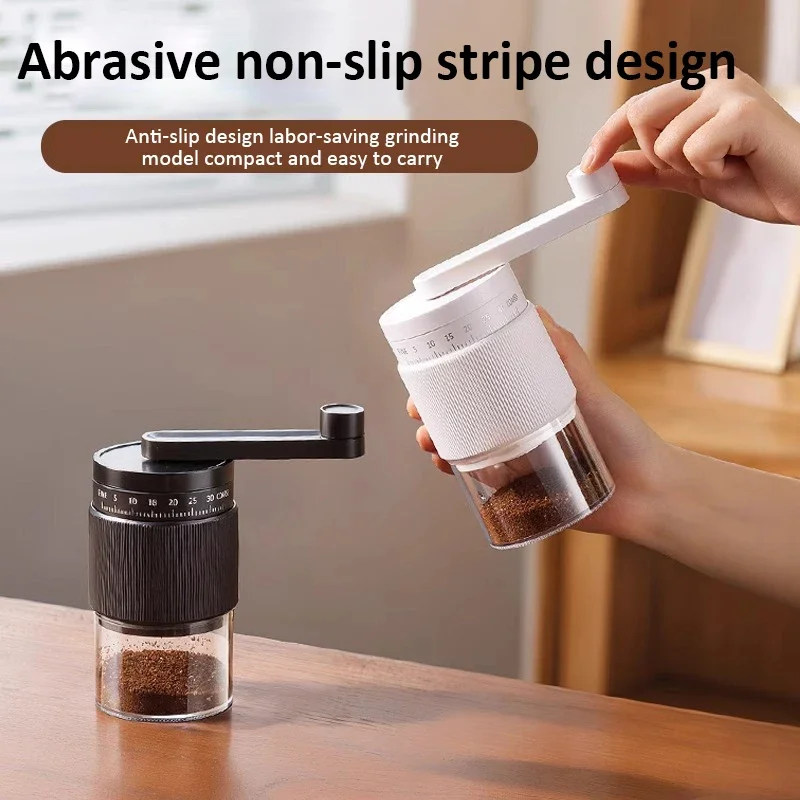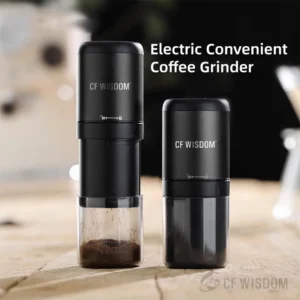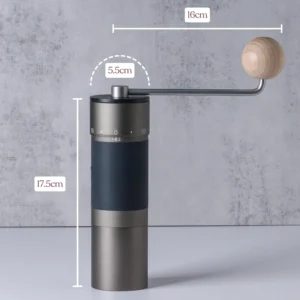Understanding Why Grind Size is Critical for Espresso Success
The perfect espresso begins with the perfect grind. But what exactly does a proper espresso grind look like? Ideally, espresso grounds should be fine and consistent—similar to powdered sugar or fine salt—creating a powder-like texture that allows for optimal extraction under pressure.
Getting your grind size right is perhaps the most critical factor in brewing exceptional espresso. The relationship between grind size and extraction quality is direct and uncompromising: too fine, and your espresso will taste bitter and burnt; too coarse, and it will be sour and watery. This fundamental principle holds true regardless of what espresso machine you’re using, from entry-level home models to commercial-grade equipment.
The challenge many coffee enthusiasts face is that different espresso machines may require slightly different grind settings to achieve optimal extraction. Despite this challenge, fine-tuning espresso grind size is a learnable skill that dramatically improves your coffee quality.
What makes this process so essential is that grind size affects how water interacts with coffee particles—controlling extraction rate, flavor development, and ultimately, the quality of your espresso. Mastering this adjustment is the difference between mediocre and magnificent shots, regardless of how expensive your equipment might be.
For those seeking to elevate their espresso experience, investing in quality equipment is crucial. Our selection of espresso coffee hand grinders offers precision and consistency for those serious about perfecting their espresso preparation.
The Science of Extraction: How Grind Size Controls Your Espresso
Understanding the physics behind espresso extraction helps explain why grind size matters so much. When pressurized water (typically 9 bars of pressure) forces its way through compacted coffee grounds, it’s engaging in a sophisticated extraction process where particle size determines resistance.
Grind size directly impacts three critical factors:
- Water flow rate: Finer grounds create more resistance, slowing water flow; coarser grounds allow water to pass through more quickly.
- Surface area exposure: Finer particles have greater surface area exposed to water, accelerating extraction.
- Extraction time and efficiency: The combination of flow rate and surface area determines how quickly and thoroughly compounds are extracted from the coffee.
When your grind is too coarse, water rushes through too quickly, resulting in under-extraction. This produces sour, sharp flavors, watery texture, and a disappointingly fast shot. Visually, the espresso looks pale with thin, disappearing crema.
Conversely, when your grind is too fine, water struggles to penetrate the compact puck, causing over-extraction or even complete blockage (choking the machine). This creates bitter, harsh, and astringent flavors with excessively slow flow—sometimes just dripping.
The sweet spot—where magic happens—is when your grind size creates just enough resistance for water to flow steadily through the puck, extracting the perfect balance of compounds. This typically results in a 25-30 second extraction for a 1:2 ratio (18g coffee in, 36g espresso out), producing rich body, balanced sweetness, and complex flavors.
The relationship between grind size and espresso flavor profiles is something every barista must master to achieve exceptional results. Understanding this relationship allows you to troubleshoot problems and adjust your approach based on what you’re tasting.
The Universal Dialing-In Process: A Step-by-Step Approach
“Dialing in” refers to the methodical process of finding the optimal grind setting for your specific coffee and machine combination. While different equipment may require slightly different specific settings, the process itself is universal and can be applied to any espresso setup.
Follow these steps to dial in your espresso:
Start with a baseline setting: Begin with either the manufacturer’s recommendation or a medium-fine setting. If you’ve used your grinder for espresso before, use your previous successful setting as a starting point.
Prepare a consistent dose: Weigh your coffee carefully (typically 18g for a standard double shot) and ensure consistent distribution and tamping pressure. Consistency in these variables isolates grind size as the factor being tested.
Pull a test shot: Start your extraction and time it from the moment the pump activates until you reach your target yield (typically a 1:2 ratio—so 36g of espresso from 18g of coffee).
Evaluate the extraction: Note the extraction time, observe the flow, and taste the result. The ideal time for most modern espresso is between 25-30 seconds.
Make incremental adjustments:
– If the shot extracted too quickly (under 20 seconds) or tastes sour/sharp, adjust your grinder finer
– If the shot extracted too slowly (over 30 seconds) or tastes bitter/harsh, adjust your grinder coarser
– Always make small adjustments—smaller than you think necessaryPurge your grinder: After each adjustment, run a small amount of coffee (2-5g) through the grinder to clear any retained grounds from the previous setting.
Repeat the process: Pull another shot and evaluate again. Continue making incremental adjustments until you achieve optimal extraction.
The key to successful dialing in is changing only one variable at a time—in this case, grind size. Keep your dose, tamping pressure, and other factors consistent to accurately assess how grind adjustments affect extraction.
When you encounter persistent issues with your espresso shots, our guide on troubleshooting espresso grind issues offers specific solutions for common problems.
Different Espresso Machine Types and Their Grind Requirements
Different espresso machines operate with varying pressure systems, temperature stability, and basket designs—all affecting the ideal grind size. Understanding these differences helps you adapt your approach to each machine type.
| Machine Type | Typical Pressure | Relative Grind Requirement | Notes |
|---|---|---|---|
| Manual lever | Variable (5-9 bar) | Slightly coarser | More forgiving due to pressure profiling |
| Semi-automatic | 9 bar | Standard espresso fine | Consistent pressure requires precise grind |
| Super-automatic | 15+ bar | Slightly coarser | Internal brewing systems often need coarser grind |
| Machines with pressurized portafilters | 9-15 bar | Medium-fine to fine | Can work with less precise grind |
| Machines with non-pressurized baskets | 9 bar | Very fine, precise | Demands high grind quality and precision |
The pressure profile of your machine significantly impacts grind requirements. Traditional 9-bar machines need a consistent, fine grind to create proper resistance. Machines with pressure profiling or pre-infusion capabilities can often extract well from a slightly wider range of grind sizes, as they manage pressure dynamically during extraction.
Pre-infusion—where water saturates the puck at lower pressure before full extraction—can be particularly forgiving of minor grind inconsistencies. However, this doesn’t eliminate the need for proper grinding; it simply provides a wider margin for success.
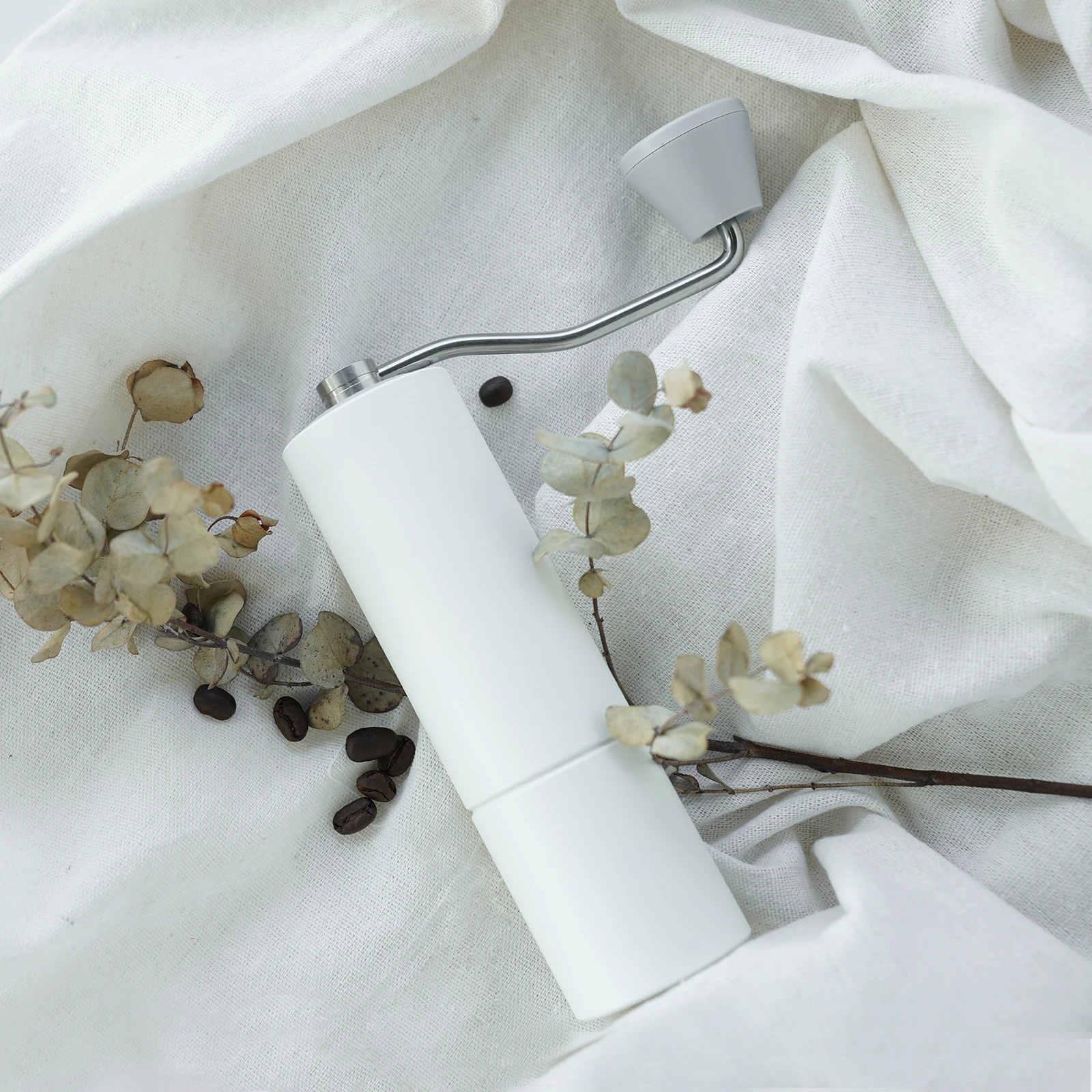
Finding the perfect grind for your specific machine requires both understanding these general principles and experimenting with your particular setup. For those seeking optimal results across different brewing methods, our precision manual grinder collection offers the versatility and control needed for consistent results.
Common Grinder Types and How to Adjust Them
The type of grinder you use significantly impacts how you’ll approach grind adjustment. Understanding your grinder’s design and adjustment mechanism is essential for making precise changes.
Stepped vs. Stepless Grinders:
– Stepped grinders have predetermined adjustment points that click into place. They’re easier to use but offer less precision.
– Stepless grinders allow infinite adjustment between coarse and fine settings, providing maximum control for espresso but requiring more skill to use consistently.
Conical vs. Flat Burr Designs:
– Conical burrs typically produce more textured particles with a wider distribution, often yielding more complex flavors.
– Flat burrs tend to create more uniform particles, generally resulting in cleaner, more defined flavors.
Most grinders adjust in consistent ways, though the specific mechanism varies:
- Collar adjustments: Typically, turning clockwise produces a finer grind, while counter-clockwise yields a coarser grind.
- Dial or wheel adjustments: Often found on the side of the grinder, these usually follow the same clockwise/counter-clockwise convention.
- Lever or slider adjustments: These directly control the distance between burrs, with positions closer together producing finer grounds.
When making adjustments, follow these best practices:
- When adjusting to a finer setting, run the grinder while making the adjustment to prevent the burrs from jamming against coffee particles.
- Always make small, incremental changes—smaller than you think necessary. A tiny adjustment can dramatically affect extraction.
- Purge 2-5 grams of coffee after each adjustment to clear the grinding chamber of grounds from the previous setting.
For those seeking precision grinding capabilities for espresso, our fine adjustment hand grinder collection offers reliable tools for achieving the consistency needed for perfect extraction.
The Art of Tasting and Analysis: Reading Your Espresso
Developing a systematic approach to evaluating your espresso is crucial for making informed grind adjustments. This sensory feedback loop connects what you taste to the adjustments you should make.
When analyzing your espresso, consider these key indicators:
Visual Cues:
– Flow rate: Should be steady and honey-like, neither gushing nor dripping
– Crema: Look for thick, persistent crema with tiger-striping (dark and light streaks)
– Color: Rich caramel to dark brown, not pale or black
Taste Indicators:
– Sourness: Indicates under-extraction, requiring a finer grind
– Bitterness: Suggests over-extraction, needing a coarser grind
– Sweetness: The goal—indicates proper extraction
– Balance: Harmonious flavors without any single note dominating
Tactile Feedback:
– Body: Should be rich and substantial, not thin or thick/muddy
– Texture: Silky and smooth rather than watery or grainy
The key is establishing a logical connection between what you observe and how you adjust:
- If your shot pulls too quickly (under 20 seconds), tastes sour, and looks thin with pale crema → Grind finer
- If your shot pulls too slowly (over 30 seconds), tastes bitter, and looks dark with delayed flow → Grind coarser
- If your shot extracts in 25-30 seconds, tastes sweet and balanced with rich golden crema → Maintain that setting
Understanding how to interpret these signals allows you to make precise adjustments. For more detailed guidance on the relationship between extraction time and grind size, our resource on adjusting grind size for espresso shot timing offers valuable insights.
Adapting to Variables: When to Change Your Grind Setting
Even after finding your perfect grind setting, various factors will require ongoing adjustments. Being aware of these variables helps you anticipate when changes are necessary rather than wondering why your previously perfect shots suddenly taste different.
Key factors requiring grind adjustments:
New coffee beans: Different origins, roast levels, and processing methods extract differently. Lighter roasts typically require finer grinding than darker roasts, while naturally processed coffees often need different settings than washed coffees.
Bean age: As coffee ages, it releases carbon dioxide and undergoes chemical changes. Fresh beans (1-7 days off roast) may need a coarser grind, while older beans (2+ weeks) typically require progressively finer grinding as they continue to age.
Environmental changes: Increases in humidity cause coffee to absorb moisture, requiring a coarser grind. Temperature fluctuations can also affect bean density and extraction rates.
Dose changes: Adjusting the amount of coffee in your portafilter necessitates grind adjustments. More coffee (higher dose) typically requires a slightly coarser grind; less coffee needs a finer grind.
Equipment changes: Switching portafilter baskets, changing gaskets, or performing machine maintenance can all affect flow rate and pressure, requiring grind adjustments.
Understanding how coffee grind affects pressure and flow helps you anticipate these necessary changes rather than reacting after experiencing poor shots. Being proactive about grind adjustment as conditions change will maintain consistency in your espresso quality.
Troubleshooting Common Grind-Related Espresso Problems
Even experienced baristas encounter extraction challenges. Identifying whether these problems stem from grind issues—and how to address them—is key to consistent quality.
Problem: Channeling (uneven extraction with fast streams)
– Cause: Often due to uneven grounds distribution or particle size inconsistency
– Solution: Ensure your grinder produces consistent particle sizes. Distribute grounds evenly before tamping. Consider using the WDT method (stirring grounds with a fine tool).
Problem: Spurting or spraying from portafilter
– Cause: Usually indicates channels in the puck, often from clumpy grounds
– Solution: Adjust your grinder to reduce clumping. Ensure proper distribution before tamping.
Problem: Inconsistent shot times despite consistent technique
– Cause: Likely grinder inconsistency or retention issues
– Solution: Clean your grinder thoroughly. Consider single-dosing to minimize retention.
Problem: Persistent sourness despite finer grinding
– Cause: May indicate temperature issues rather than just grind
– Solution: Check your machine’s temperature. Try temperature surfing or increasing brew temperature.
Problem: Shots running much faster/slower than usual with no setting changes
– Cause: Environmental changes or bean aging
– Solution: Adjust grind to compensate for humidity, temperature, or bean freshness changes.
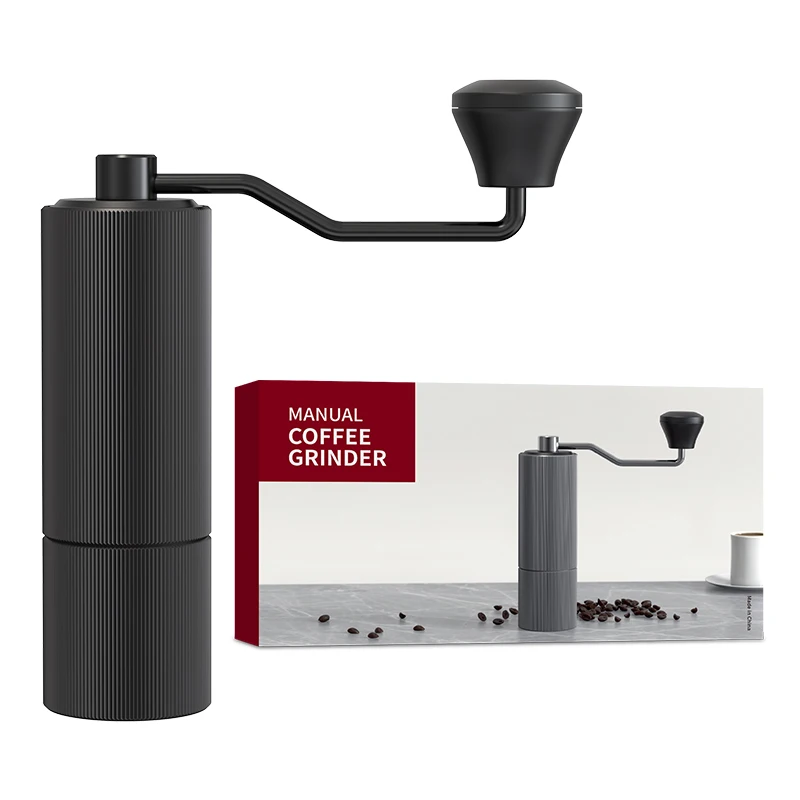
When diagnosing issues, always consider whether the problem truly stems from grind size or if other variables might be at play. Understanding how grind size affects espresso provides the foundation for effectively troubleshooting extraction problems.
Practical Tips for Consistency Across Different Machines
Achieving consistent results—especially when working with different machines—requires systematic approaches beyond just grind adjustment. These practical strategies help maintain quality across equipment variations.
Keep a coffee journal: Record grind settings, coffee details, extraction times, and tasting notes. This valuable reference helps you quickly dial in when switching between machines or coffees.
Practice single-dosing: Grinding only what you need for each shot minimizes retention and ensures fresher grounds with more consistent particle distribution.
Use the WDT technique: The Weiss Distribution Technique—stirring grounds with a fine needle tool—breaks up clumps and ensures even density before tamping.
Master temperature management: Learn to “temperature surf” on machines without precise temperature control by timing shots after the heating cycle completes.
Establish a cleaning routine: Regular maintenance prevents inconsistencies caused by grinder buildup or machine issues.
Standardize your workflow: Develop consistent habits for dosing, distribution, and tamping to isolate grind size as the primary variable.
Fine Adjustment Hand Grinder, Precision Manual Grinder, Travel Coffee Grinder
Price range: $185.11 through $494.63 Select options This product has multiple variants. The options may be chosen on the product pageHand Burr Grinder, Hand Crank Coffee Grinder, Manual Espresso Grinder, Portable Coffee Grinder
Price range: $262.72 through $300.22 Select options This product has multiple variants. The options may be chosen on the product pageHand Burr Grinder, Manual Coffee Grinder Stainless Steel, Precision Manual Grinder
Price range: $183.64 through $187.52 Select options This product has multiple variants. The options may be chosen on the product pageManual Coffee Grinder Stainless Steel, Manual Espresso Grinder, Travel Coffee Grinder
Price range: $276.22 through $276.39 Select options This product has multiple variants. The options may be chosen on the product pageHand Crank Coffee Grinder, Manual Coffee Grinder for Espresso, Manual Coffee Grinder Stainless Steel
$349.15 Select options This product has multiple variants. The options may be chosen on the product page
For coffee enthusiasts who frequently switch between brewing methods or machines, our collection of manual coffee grinders for espresso offers the versatility and precision needed for consistent results across different setups.
Is It Really the Grind? Other Factors Affecting Espresso Extraction
While grind size is fundamental to espresso quality, other variables can mimic grind-related issues. Before making dramatic grind adjustments, consider these potential culprits:
Water temperature fluctuations: Inconsistent temperature can cause extraction variations that seem like grind problems. Lower temperatures emphasize acidity (similar to coarse grinding), while higher temperatures increase bitterness (resembling too-fine grinding).
Inconsistent tamping: Variations in pressure or levelness create density differences that affect water flow, potentially masking or mimicking grind issues.
Distribution problems: Uneven distribution of grounds in the portafilter leads to channeling and inconsistent extraction, regardless of grind size.
Water quality issues: Mineral content affects extraction and can alter taste in ways that seem like grind problems. Hard water tends to emphasize bitterness, while soft water may enhance perceived acidity.
Coffee freshness: Stale coffee extracts differently than fresh coffee, often requiring finer grinding but still producing flat flavors.
To isolate variables, use this simple diagnostic approach:
1. Verify temperature consistency
2. Standardize tamping pressure and technique
3. Ensure even distribution before tamping
4. Control for dose accuracy with a precise scale
5. Only then make grind adjustments
This methodical approach prevents unnecessary grind adjustments when other factors are the true culprits.
When to Consider Upgrading Your Grinder (And When It’s Not Necessary)
Understanding your grinder’s capabilities and limitations helps you determine when technique improvements will suffice versus when equipment upgrades might be necessary for your espresso goals.
Grinder limitations that affect adjustment capability:
Adjustment mechanism precision: Stepped grinders have fixed increments that may be too large for espresso fine-tuning, while stepless grinders offer infinite adjustment but can be harder to replicate exactly.
Grind consistency: Lower-quality grinders produce more varied particle sizes (fines and boulders), causing uneven extraction regardless of setting.
Retention issues: Grinders that trap grounds between uses mix fresh and old coffee, compromising consistency between shots.
When upgrading might be beneficial:
– You’ve mastered technique but still experience inconsistent results
– Your grinder can’t produce fine enough grounds for proper espresso
– Shot quality plateaus despite careful adjustment and technique
– You’re consistently experiencing channeling despite proper distribution
When to focus on technique instead:
– You haven’t fully explored your current grinder’s capabilities
– You haven’t developed consistent dosing and tamping habits
– You’re still learning to taste and identify extraction issues
– Your current equipment produces acceptable results, but your workflow needs improvement
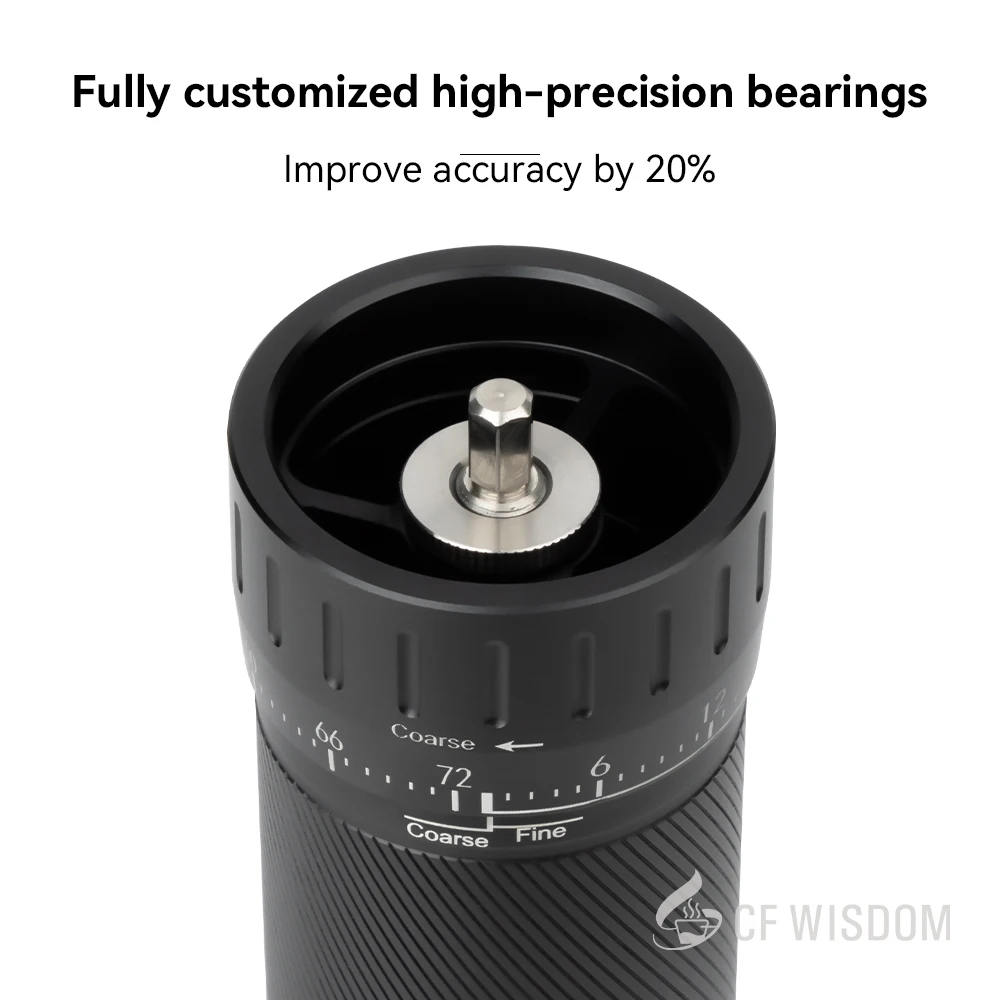
For those ready to upgrade their espresso experience, Savor Suite offers a range of manual espresso grinders designed specifically for achieving precision and consistency in espresso preparation.
Conclusion: The Ongoing Journey of Espresso Grind Mastery
Mastering espresso grind adjustment is not a destination but a continuous journey. Even professional baristas regularly fine-tune their approach as coffees change, equipment ages, and environments shift. This ongoing calibration is part of the craft’s beauty—each adjustment brings new learning opportunities and taste experiences.
The most important takeaway is that grind size adjustment is a fundamental skill that enhances all other aspects of espresso preparation. Without proper grinding, even perfect tamping, ideal temperature, and premium beans cannot rescue your shot quality.
Remember that perfection comes with practice and patience. Each adjustment teaches you something about your coffee, your equipment, and your preferences. Over time, these micro-adjustments become intuitive, allowing you to diagnose and correct extraction issues quickly.
Embrace the experimental nature of this process. Keep notes, taste attentively, and make deliberate adjustments. The reward—that perfectly balanced, sweet, and complex espresso shot—makes the effort worthwhile. And as your palate develops, so too will your appreciation for the subtle nuances that perfect espresso grind size brings to your daily coffee ritual.

